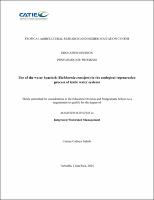| dc.description.abstract | Water contamination remains a critical global issue, exacerbated by population growth, accelerated urbanization, and economic development. This issue significantly impacts the well-being of humans, wildlife, and ecosystems. To address this problem, various methods have been introduced, including phytoremediation, which involves the use of aquatic plants such as the water hyacinth (Eichhornia crassipes) to remediate polluted water bodies. This study aimed to develop and evaluate an assisted phytoremediation approach, integrating aeration and electromagnetic fields with Eichhornia crassipes to enhance the removal of potentially toxic chemicals and nutrients. It investigated the removal and absorption efficiency of water hyacinths using an innovative technology that incorporates the addition of air or electromagnetic fields (treatments) over a seven-day period (time). The linear and mixed model showed that time had a significant effect (p < 0.05) on the water hyacinth, whereas the treatments and the interaction
between time and treatments were not significant, suggesting that the effect of time is consistent across different treatments and that treatments do not contribute to changes over time. When analyzing the water analysis for removal efficiency, it indicated that the water hyacinth is effective in removing phosphorus, copper, iron, and aluminum, with removal efficiencies of 75.0%, 74.2%, 68.9%, and 20.0, respectively. The absorption efficiency using the foliar analysis indicated that the water hyacinth was effective in accumulating nitrogen, phosphorous, iron, copper with absorption efficiencies of 7.7%, -11.6%, -26.8%, 883.6%, and 2.2%, respectively. The findings of this study highlight the water hyacinth's significant capacity for the removal and
absorption of contaminants such as phosphorus, iron, copper, and aluminum and its potential as a promising and environmentally sustainable technology. | es_ES |


